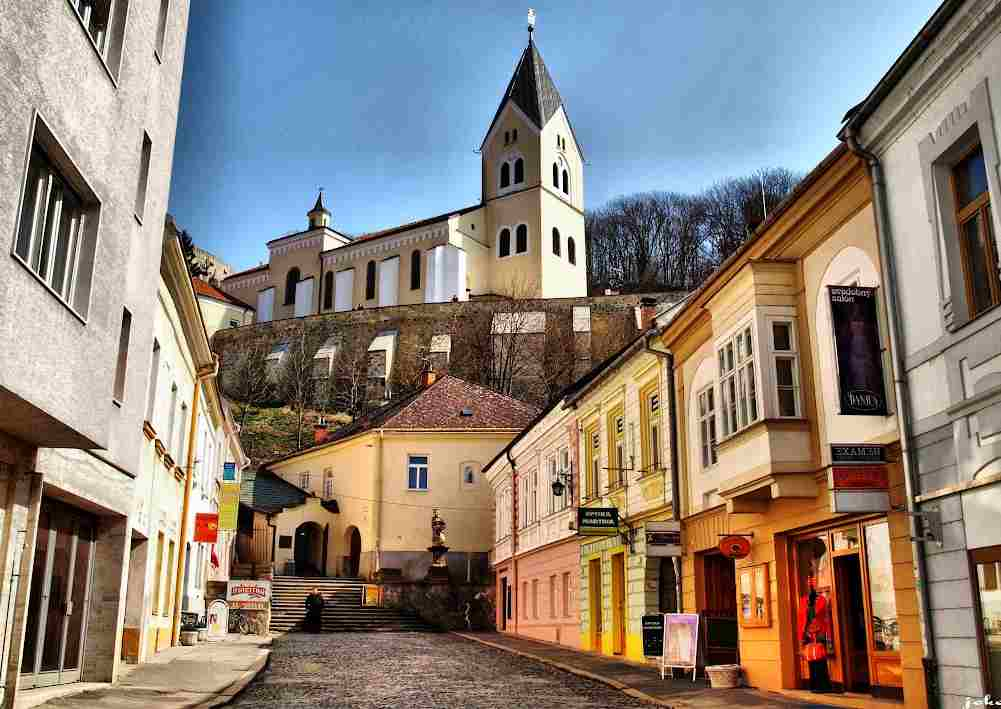a slovenly slowdown in
SLOVAKIA

by
JOHN M. EDWARDS
_____________________________________
John M. Edwards middlenamed his daughter after his favourite
travel writer, Bruce Chatwin. His work has appeared in Amazon.com,
CNN Traveller, Missouri Review, Salon.com, Grand Tour, Michigan
Quarterly Review, Escape, Global Travel Review, Condé
Nast Traveler, International Living, Emerging Markets
and Entertainment Weekly.
“I
am the best artist in Slovakia,” the best artist in Slovakia
bruited. With a cavalier wave of his hand, curved like a grinning
alligator shadow puppet, he added in slow mo, “I paint
you a picture you would never believe.”
“Oh,
really?” I said with a terse forced smile. “I really
would like that.” Inside, I waited for explicit details
of the con.
“But
you have not yet met my beautiful wife!” -- (ugly as sin).
The
artist helped his giggly Mata Hari up from the wooden park bench
at the campground where I was staying, in an atmospheric boat
hotel, straight out of the shocker Hostel movies, on
a forgetful river outside Trencin, Czechoslovakia.
“How
do you do?” Mata Hari extended a limp limb evocative of
a paralyzed veal kotlet pounded flat by a Wolfgang Puck acolyte.
Man,
I thought, this slag is hurting.
With
her peroxide-blonde hair, resembling an ill-fitting wig or some
potted plant out of Baudelaire’s Fleurs du Mal, plus her
Kim Carnes outfit and Betty Davis eyes, all I could think of
was: “Whatever Happened to Baby Jane?”
“Meet
me tomorrow here, early in the morning, and I take you to my
studio. I paint you a picture you will never believe.”
We
shook on it.
Even
though at first I had no intention of actually showing up, I
began to wonder whether this outlandish comic character could
turn me on to some much-needed laughing attacks.
Just
because.
I found
traveling in a rented and (probably) ‘bugged’ Skoda
car through the postcardy Slovak countryside -- with horse-drawn
carts trotting down dirt roads, pitchfork-wielding paesano cuckolds
collecting hay into bales, and the occasional syringe-shaped
church spire poking up into the swirling veils and varicose
veins of nuclear Central European sunsets -- to be, ah, I don’t
know: picturesque?
* * * * * * * * * *
I realized
how laughably unprepared I was for this trip.
Having
grown up during the Cold War, even learning at school that children
were often separated there from their parents to be trained
as superhuman Olympic athletes (or Nietzsche’s Ubermenschen),
I was totally naïve about real life behind the so-called
Iron Curtain.
All
I knew was that if I went there Big Brother would not only be
watching but would think nothing at all about snitching on me.
The secret police were everywhere.
My
brief subscription to Soviet World magazine was unenlightening.
Pictures of hydroelectric dams and vast steel works glowing
red under the ubiquitous Hammer and Sickle motif (all  Western-style
ads were strictly no-go), as well as confetti-filled streets
filled with goose-stepping soldiers and oompah-pah bands, didn’t
tempt.
Western-style
ads were strictly no-go), as well as confetti-filled streets
filled with goose-stepping soldiers and oompah-pah bands, didn’t
tempt.
Little
did I know that the very totalitarianism that kept people’s
mouths shut also contributed to not tearing down any of the
historic architecture scattered across such Central European
Soviet satellites as Czechoslovakia, Hungary, and Poland. Indeed,
many Slovak towns seemed frozen in time, almost as if they had
not changed much in the last few centuries.
*
* * * * * * * * *
This
was serious.
I was
running out of cigarettes.
In
a stalled economy governed by the Marxist-Leninist Five Year
Plan, where everyone had to wait in line for basic necessities
like stale bread and rubber boots, I was uncertain where exactly
to acquire a pack of smokes (except perhaps at one of the government-run
foreign-currency Tuzex shops). Even some Soviet brands, such
as Russian Cosmos cancersticks, would do in a pinch.
And
that’s when I met Rasto, a defiant Slovak with a black
concert Metallica T-shirt and a long mane of wavy brown hair.
Although he spoke little to no English, he was certainly familiar
with all of our bands: “Dip Purple, Blau Oysta Cult, Roosh,
Arrowschmidt.”
And
also, of course, my favourite: “Pink Flood.”
But
then again, what did I know about Czechoslovak samizdat pop.
How do you pronounce ‘Prazhky Vyber’? In exchange
for a Peter Gabriel cassette (which I could tell from his blasé
unsurprised expression was old hat to him), he only very reluctantly
handed over the PV tape.
I
checked out this musical novelty in my portable Walkman, and
said, “Wow, a little like Frank Zappa.”
Rasto
smiled, as if this might in fact be his own band, and then led
me off to a local watering hole, which unfortunately involved
trespassing over some hedges and hopping a bus for which none
of us pointedly paid. Where on earth were we going -- this far
just to cop a pack of invariably recycled tobacco?
We
finally arrived and all got shot glasses of red Slovak wine,
which was strong and lip-smacking good. Then Rasto seemingly
got into an argument over acquiring the Czech-made smokes with
the kavarna manager, who kept looking over at me with
arch suspicion, raising his eyebrows when Rasto kept repeating,
“Americano, Americano.”
As
I gathered from the tirade, true to communist regulations, it
was unlawful to sell cigarettes after a certain time for absolutely
no good reason at all.
Finally
Rasto ripped out a pack from the startled manager’s hands,
and we left pronto, again without paying a red cent.
Maybe
communism really was free.
Another
long free bus ride and we arrived at Rasto’s apartment
block in a virtual sea of identical edifices.
There
was something vaguely alienating about Stalinesque concrete-block
suburbs like this one. Though the centrum of Trencin was pleasant
and historic enough, but filled with science-fictiony ‘steampunk’
touches like some sort of radio tower shaped like the Czechoslovak
defector Ivan Lendel’s tennis racket, there was no way
I could find myself around a distinctly dystopian workers’
utopia.
Once
inside his apartment, which really did resemble an unfinished
stage set -- -maybe we were being filmed? I looked around at
the curtains blocking off exposed carpentry and water pipes.
But
upon entering the living room, I spied that everything looked
comfortably bourgeoisie: nice furniture and modern appliances.
Even a potted plant, which I immediately suspected hid some
sort of listening device.
From
the fridge Rasto pulled out some delicious chook: drumsticks.
Which was better than anything I had eaten in the cafeteria-style
restaurants: bad borscht, black bread, and hardboiled eggiwegs.
I was
beginning to wonder if Rasto was in fact some sort of high-ranking
communist hack or football hooligan, when I noticed on the bookshelf
not only Charles Bukowski, who was always popular in commieland
for his grim depictions of capitalist America, but I was surprised
indeed to see a bunch of Norman Mailer books, including An
American Dream. (Surely that decadent novel, as subversive
as “Ren and Stimpy,” could not pass muster with
the official communist censorship).
Rasto
got across somehow that his mother had found the books, in a
language he couldn’t read. Everything seemed all for show.
He
also asked me what countries in Europe I had been to. “Hmm,
let’s see, France, England, Belgium, Holland, Spain, Italy
. . . .”
Rasto
was smiling. “Nicht Europe?”
I didn’t
know what he meant.
Until he brought over a world atlas from the bookshelf, where
Western Europe figured prominently as a sizable gray blotch
– seriously.
It
seemed almost as if the demesnes of democracy had been wiped
clear as a blackboard by some Chernobyl-like disaster.
Wow,
I couldn’t believe it.
“Germany?”
I offered.
Rasto
nodded his head sagely: he had been there once: “Dresden.”
Wondering
about the Slovaks’ Weltanschaung (worldview), I asked
carefully. “Communism ist gut?”
“Nein,
nein, Communismo nicht gut,”
I
relaxed and felt like I was finally exiting an episode of “The
New Twilight Zone.”
After
sitting around in mostly friendly silence, both of us fatigued
at pantomiming, I asked how on earth do I get back to the campground?
He
indicated I could stay in his apartment.
I nervously
confided by miming putting in contact lenses that I really,
really, really had to get back to the campground. “Emergencia.”
I was soaking my lenses in enzymes.
As
one of millions of Slovak engineers, he seemed to know this
word.
So
we left the probable movie set and Rasto flagged down a random
car, explaining the ‘sitch.’As if on a sudden secret
mission, with a wince of horrorshow excitement, the random driver
barreled down the road with his dim headlights like little old
Alex from A Clockwork Orange.
* * * * * * * * * *
At
cockerel crow, I woke up.
Rubbing
the sleepyseeds from my eyes, I slipped in my contacts which
burned slightly, then walked into my 501 Levi’s (then
an alternate currency on the black market) and dropped my extra-large
baggy blue shirt (to hide my over-the-shoulder money pouch).
I brushed my teeth with bottled water and pulled back my hair
into a ponytail, sprucing up in case I was going to become a
portrait of the tourist as a dumb guy.
Anyway,
I waited like a goddamned Godot for over an hour, but ‘the
best artist in Slovakia’ never showed up. I don’t
know: maybe he was arrested or something?
NOTA
BENE: Since splitting from Czechoslovakia, Slovakia proper
has changed a lot. In fact, the Quentin Tarantino/Eli Roth film
shocker Hostel was set in Slovakia, but filmed in the
Czech Republic, amid much controversy.
also by John M. Edwards:
Poland:
Potent Potables
Confessions
of a Tasmaniac
The
Bulgarian Way
Sumatra's
Hex & Sex
Kutna
Hora and the Chapel of Bones
Remembering
Bruce Chatwin
Coffe
Art of Sol Bolaños